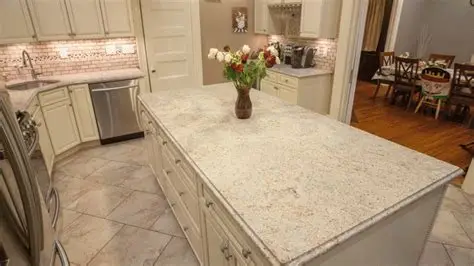Granite is one of the most durable natural materials you can bring into a kitchen or bath. From salt-and-pepper granite stone to dramatic black slabs, it resists heat, stands up to daily use, and stays timeless. But to keep that depth of shine and clarity, the right cleaners—and the right technique—matter. This guide covers exactly what to use to clean granite countertops, what to avoid, how to remove stains without damage, and smart maintenance that preserves both beauty and resale value.

Why Granite Needs Stone-Safe Cleaners
Granite is an igneous rock composed primarily of quartz and feldspar with mica and accessory minerals. Those minerals make granite hard and scratch resistant, but the surface is still micro-porous, which means the wrong chemicals can degrade the sealer, dull the finish, or cause etching—especially on dark or black granite countertops and on honed or leathered finishes. The golden rule: stick to pH-neutral, non-abrasive products.

The Short List: What to Use on Granite (Everyday & Deep Clean)
Everyday Cleaning (Food Prep, Spills, Fingerprints)
- pH-neutral stone cleaner labeled safe for natural stone.
- Warm water + a tiny drop of dye-free dish soap (mild, non-citrus).
- Soft microfiber cloths and a non-abrasive sponge.
Weekly/Deep Refresh
- Stone cleaner followed by a distilled water rinse to prevent mineral spotting.
- Dry buff with a fresh microfiber for a streak-free polish.
Disinfection (As Needed)
- 70% isopropyl alcohol spritzed lightly; let dwell 3 minutes, then rinse and buff dry. Reserve for times you truly need to sanitize.
For a quick, stone-safe shopping list and more recipes, see What to Clean Granite With?
What NOT to Use on Granite (and Why)
- Vinegar, lemon, citrus cleaners: acidic—can etch and dull.
- Bleach, ammonia, peroxide blends, harsh degreasers: degrade sealers, cause haze.
- Glass cleaner: often ammonia-based; leaves a film.
- Abrasive powders, scouring pads, steel wool, magic erasers: create micro-scratches.
- Generic “descalers” and bathroom acids: etch polished faces and open pores.
These mistakes are the most common reasons homeowners think their “granite is worn out” when it’s actually just chemically dulled or abraded.
Step-by-Step: The Perfect Granite Clean
1) Dry Dust First
Use a clean, dry microfiber to lift crumbs and grit. Removing particles before moisture prevents micro-scratches.
2) Spray Cleaner Sparingly
Mist a pH-neutral stone cleaner or warm water with a drop of mild dish soap. More soap ≠ cleaner counters; it just increases residue.
3) Wipe in Overlapping “S” Patterns
Work from the backsplash forward. Flip the cloth to clean sides as you go so you’re not pushing oils around.
4) Rinse (Optional but Great on Dark Granite)
Lightly mist with distilled water and wipe again. Distilled water minimizes mineral spots on black granite countertops.
5) Buff Dry to Shine
Use a fresh, dry microfiber to polish the surface to a streak-free finish. This one habit keeps granite looking professionally maintained.
DIY Stone-Safe Cleaner & Poultice Recipes
Always spot-test in an inconspicuous area first.
Gentle Everyday Cleaner
- 2 cups warm water
- 1–2 drops dye-free, non-citrus dish soap
Mix gently to avoid suds. Spray, wipe, rinse with clean water, and buff dry.
Disinfecting Spray (Use Occasionally)
- 70% isopropyl alcohol (pre-mixed or diluted from 91% with distilled water)
Spray lightly, let sit 3 minutes, rinse, and buff dry.
Universal Poultice Base for Stains
- Baking soda + water (oil stains) or baking soda + 3% hydrogen peroxide (organic stains)
Mix to peanut-butter consistency, spread ⅛–¼″ thick over the stain, cover with plastic, poke pinholes, leave 24–48 hours, remove, rinse, dry, and repeat if needed.
Stain-by-Stain Guide (Granite Countertops)
Oil-Based (olive oil, butter, cosmetics)
- Look: Darkened, “wet” patch that lingers.
- Fix: Baking soda + water poultice; repeat cycles until the stain lifts.
Organic (coffee, tea, wine, juice)
- Look: Brownish rings or splotches.
- Fix: Baking soda + 3% peroxide poultice; rinse thoroughly after removal.
Rust (from cans, tools, metal feet)
- Look: Reddish-orange discoloration.
- Fix: Use a granite-safe rust remover only; avoid generic rust gels.
Hard Water/Soap Film (baths & around faucets)
- Look: Cloudy haze or crust near fixtures.
- Fix: Soften with warm distilled water compress, then stone cleaner, rinse, and buff.
Sealing Granite: Do You Need It? How Often?
Many granites are dense, but most clean granite countertops benefit from a periodic penetrating/impregnating sealer. It buys you cleanup time—stain resistance, not stain proofing.
- Water-Drop Test: Put a teaspoon of water on the surface.
- If it darkens in 5–10 minutes, reseal.
- If it beads for 30+ minutes, you’re still protected.
- Typical Frequency: Every 1–3 years (honed or very light colors may need it sooner).
- Application Keys: Clean → dry → apply per label → wipe off excess thoroughly → allow full cure before heavy use.
Care Differences: Polished vs. Honed vs. Leathered Granite
- Polished granite: High gloss, naturally more resistant to staining; shows streaks if not buffed dry.
- Honed granite: Matte, trend-forward; requires meticulous rinsing and more frequent sealing because open pores can hold residue.
- Leathered/antiqued granite: Textured; use a soft nylon brush with stone cleaner to reach micro-valleys.
Granite vs. Quartz: Cleaning & Maintenance
- Granite countertops: pH-neutral cleaners, occasional sealing, superior heat tolerance.
- Quartz (engineered): No sealing, similar daily cleaning, but avoid strong solvents and protect from prolonged high heat.
If you often cut or slide cookware on the counter, read Can You Chop/Cut on Granite Countertops? to protect blades and finishes alike.
Buying Smart: Cleaners, Cloths & Tools
- Choose a concentrated stone cleaner you can dilute—more economical for large kitchens.
- Keep a stack of fresh microfibers; swapping cloths mid-clean is the secret to a streak-free result.
- Create a mini stain kit: baking soda, 3% hydrogen peroxide, plastic wrap, painter’s tape, and a commercial stone poultice.
Working with heavy slabs, islands, or backsplashes during remodels? Leave moves to pros with proper handling gear like the Aardwolf Forklift Boom FB1-2720 and other professional solutions available via Toolrange. Safe transport prevents chips and fractures that no cleaner can fix.
Troubleshooting: Dullness, Streaks, or “Film”
- Persistent streaks on dark granite: You’re likely using too much soap or not rinsing. Switch to a pH-neutral stone cleaner and add a distilled water final wipe, then buff dry.
- Cloudy film that returns quickly: Residual glass cleaner, vinegar, or degreaser may have compromised the sealer. Perform a water-drop test and reseal if needed.
- Random dull patches: Could be etching from acids or abrasion. Call a stone professional for re-hone/re-polish with diamond abrasives.
FAQ: Common Granite Cleaning Questions
Can I use dish soap every day?
Yes—one tiny drop in warm water. Too much soap causes film that’s especially visible on black granite countertops.
Do disinfecting wipes work on granite?
Some are acceptable if alcohol-based and ammonia-free. Still, rinse and buff afterward to avoid residue build-up.
Will sealing make granite maintenance-free?
Sealers dramatically improve resistance but don’t make surfaces stain-proof. Prompt blotting and stone-safe cleaners remain essential.
What about “natural vs. engineered granite” products?
True “engineered granite” is typically a resin-bound mix similar to quartz composites; follow that manufacturer’s care guide. For natural stone countertop comparison, granite usually wins for heat tolerance and long-term refinishability.
Quick Reference: The Granite Cleaning Matrix
Use:
- pH-neutral stone cleaner
- Warm water + 1–2 drops dish soap
- 70% IPA (occasional disinfection)
- Microfiber cloths, soft sponge, soft nylon brush (textured finishes)
Avoid:
- Vinegar/citrus, bleach/ammonia, alkaline degreasers
- Abrasive powders/pads, magic erasers
- Glass cleaner
- Over-soaping and not rinsing
Maintain:
- Rinse with distilled water on dark stone
- Buff dry after each clean
- Perform the water-drop test; reseal as needed
Related Resources & Next Steps
- Professional handling gear for stones and slabs: Toolrange
- Safe material movement during remodels: Aardwolf Forklift Boom FB1-2720
- What to buy and mix at home: What to Clean Granite With?
- Knife and finish protection myths: Can You Chop/Cut on Granite Countertops?

